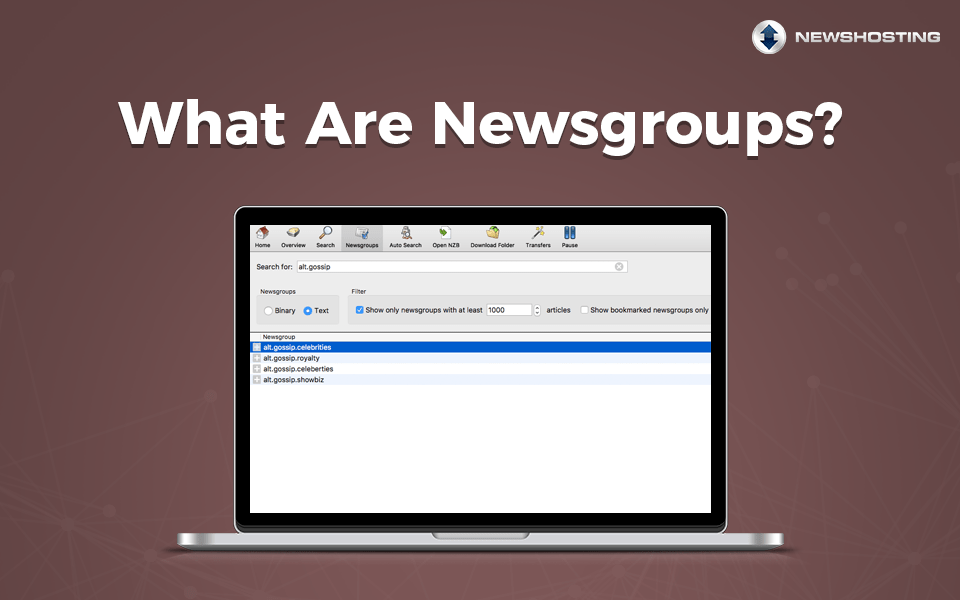When the Internet was in its infancy, there were a number of transfer protocols available. Most people didn’t realize there was legitimate competition for what “the Internet” would mean. Several networks were joined together to make what we know as the Internet today. And people no longer need to know the difference between http and nntp.
But many of those protocols still exist, and you may be missing out by not understanding when and how they can be useful. Stepping out of your comfort zone and into Usenet is a great way to open new content.
The Difference Between HTTP and NNTP
We covered this a little last week, but NNTP is the older protocol, even if HTTP is more popular today.
NNTP
The Network News Transfer Protocol (NNTP) is the way that Usenet works. The biggest benefit of it is that it allows both server/server and server/client communication. That means that it not only talks to newsreaders, but Usenet servers can talk to each other. Part of how Newshosting is able to maintain such great article retention is that our global network is constantly backing itself up.
Initially, Usenet was based on the Unix-to-Unix Copy (UUCP) protocol, but that required users to read articles on the server in question. NNTP was revolutionary in that it allowed clients to access posts so they could be read locally. This was a huge deal at the time and one of the reasons why the differences between http and nntp are still largely legacy features.
HTTP
When the World Wide Web was introduced, so too was the Hypertext Transfer Protocol (HTTP). This was an incredibly fast, versatile protocol that used a series of numeric codes to tell local computers what to expect. If you’ve ever gotten a “404 not found” message trying to access a web page, “404” is one of those codes.
HTTP is built on a server-client model. Unlike NNTP, which allows servers to talk to one another, HTTP only lets servers talk to computers. For example, you can’t have a web server that backs itself up, at least not using HTTP to do so. But that web server is always ready to send a web page to a computer or phone that requests it.
Browsers
Because these protocols have different rules for communication, they require different types of browser to function.
For HTTP, you have to use what is commonly called a “web browser” and is likely what you’re staring at right now. The most popular ones are Chrome, Safari, and Microsoft Edge, though Firefox has a strong following and some people even use more security-oriented browsers like Tor.
NNTP, on the other hand, uses a newsreader to browse its content. Newshosting, of course, provides a pre-configured newsreader, but that’s not your only option. Newsreaders like SABnzbd and NZBGet are incredibly popular for accessing binary files on Usenet. And you can even get the best of both worlds with Easynews, which is the world’s only newsreader that you can access with a web browser.
Content
Perhaps the biggest difference between HTTP and NNTP, though, is that they have different content.
Pages on the World Wide Web are highly diverse, but they are also created in a very methodical way. While a lot of websites have user generated content, like social media sites, most of the content is created by the people running the website for people viewing it. A car dealer is not also looking to buy a car, and a car buyer is not posting cars for sale.
NNTP, on the other hand, is made of user-generated content. That means that the information you find there, from job listing to binary files to threaded discussions, is made by the people accessing it instead of a page authority. If you post in a text discussion, you and other people who want to read about that topic are the ones making the content you’re consuming.
HTTP and NNTP Aren’t Completely Different, Though
Just because there are key differences between HTTP and NNTP doesn’t mean that they don’t share a lot of common traits.
For example, you’re probably familiar with website addresses that start with “https” instead of “http.” That indicates that the connection is secured using SSL. Secure Sockets Layer (SSL) is an encryption protocol that keeps online communications secure. It is the gold standard for online encryption at the moment and most websites utilize it to protect their users.
Even though NNTP doesn’t have a version with an “s” at the end, it still can use SSL. In fact, Newshosting protects all your NNTP connections with SSL. That prevents outsiders from seeing your activity or even what kind of connection it is!
Whether you’re using the World Wide Web or Usenet, you’ll be able to access a wealth of data from around the planet. There is a difference between HTTP and NNTP, but ultimately both bring people closer and foster improved communication.







